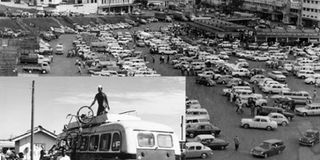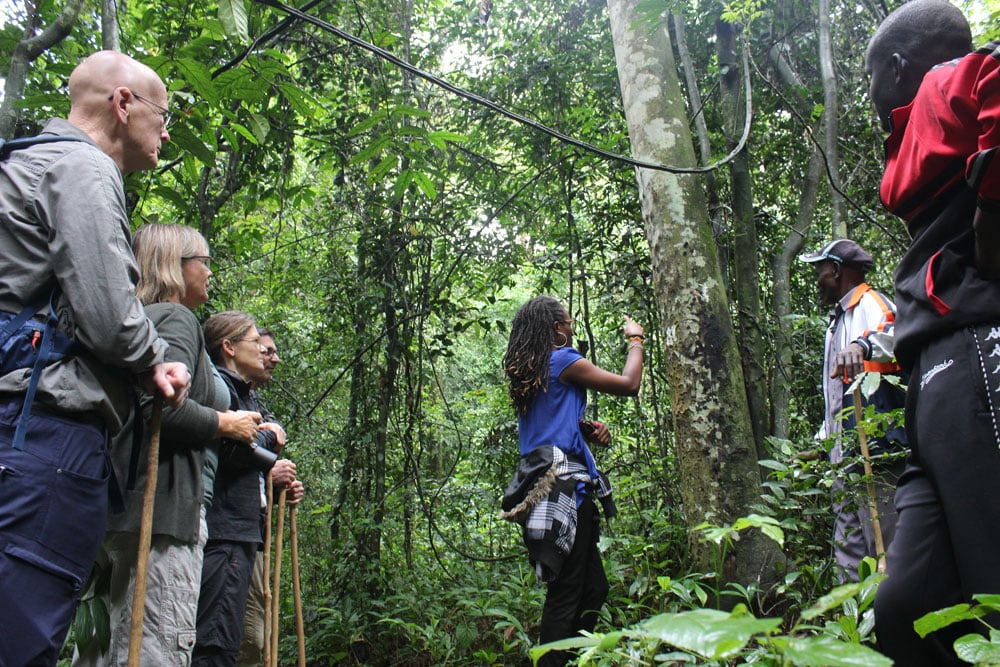The changing face of Kampala city

A panoramic view of Kampala City - Old Taxi Park in 1970s and (inset) a Ford van, precursor to Toyota Hiace with passengers loading their bicycles. COURTESY PHOTO
Kampala- “When I first came here, we used to buy merchandise and take it back home for sale because it was Kampala (city) where you would be able to buy different things. We bought goods from shops in form on lock-ups on buildings on the streets. These big shopping malls were not there,” Willian Ssemanda, a businessman and resident of Kibuli, describes what Kampala was then.
He says at that time Kampala was facing uncertainties because of the political unrest following the deposition of former President Idi Amin and the controversial general elections in 1980, followed by insurgencies as different rebel groups fought the Obote II establishment. Mr Ssemanda says even then, one still took pride to live in the city.
The congested Old Taxi Park is one of the old features that this 72-year-old man remembers among the strategic places where people would meet new friends because it was like the connection point for whoever wanted to travel to any part of the “growing” city.
Mr Ssemanda has lived in the different parts of Kampala ever since 1979 when he moved from his home district of Kyotera (formerly part of Masaka). To him, Kampala has been changing every other year depending on the business demands.
The tall buildings and congested streets characterised by people who move from one corner to another, shopping malls, the street venders calling for buyers and the begging street kids are new additions to the once serene city. Things have changed, he says, traffic lights have been fixed at different junctions on major roads.
However, the question will always be; has Kampala been like this ever since it started developing as the central business centre, political and administrative capital of Uganda? Certainly, the answers may vary depending on the time one has lived in it.
Fast development
The businesses are fast developing from the usual lock-up shops to huge buildings-shopping malls and arcades where variety is found within just one place.
According to Mr Godfrey Kirumira, the chairman of the Uganda Developers Association, business in the city has evolved every decade that passes.
He narrates that from the 1970s to mid-1990s, people were still looking at doing business of opening up shops but not looking at the more lucrative real estate business.
“At that time, everyone wanted to own a shop and that was all. But as time went on, people started realising that such shops would expand and require enough spaces. That is why you have seen people put up these skyscrapers, shopping malls and arcades to accommodate shops for goods, office space for the services and parking,” he says.
He says whenever a hotel would be talked about, one would draw their attention to Sheraton Kampala Hotel, Grand Imperial, the Nile Hotel (now Kampala Serena Hotel) and a few others in the city centre. But now, he says, hotels for accommodation, conferences and parties are scattered across the Kampala metropolitan area.
Mr Kirumira, one of the tycoons who have made their fortune from real estate says the decision by the current regime to liberalise the economy by creating a conducive environment for local and foreign investors, has played a key role in the rapid development of Kampala City. He says this has attracted many people from both within and outside the country.
The face of Kampala
One of those who was born and bred in Kampala before becoming one of the top leaders in the country is Capt Francis Baabu.
He says the population has rapidly increased from around 300,000 in the 1970s to now close to two million people. The National Housing and Population Census of 2014 puts the population of Kampala at around 1.5m people at night.
Capt Babu says initially Kampala had a different face from what it was before independence when Mengo was still a municipality under the administration of Buganda Kingdom.
“The Kampala you see started showing signs of growing into a big city when informal settlements started setting up. People from western Uganda started settling around the areas of Nateete, those from the east around Nakawa and Naguru, those from north- west in Kawempe, but all doing different kinds of work in the centre,” he says.
He notes that anyone coming to Kampala today would look at the houses such as Mapera House, NSSF building, Bank of Uganda and many more along the busy Kampala Road and imagine that is how the city looked like in the 1960s.
He says Bank of Uganda buildings sit at a place where the Central Police Station (CPS) used to be whereas the Uganda House was erected by former President Milton Obote where the Traffic Police headquarters were.
The former Kampala central Member of Parliament says what has not changed a lot is the availability of banking institutions save for the advanced technology and systems being applied today.
“Before independence, we had many banks already. Barclays, Standard Chartered, Grindlays Bank, Bank of Baroda, Bank of India are among those that were here. After independence, we saw the coming of Uganda Commercial Bank and later on the Cooperative Bank (now closed). The new banks are not game changers but they are moving with the original ones just on the new innovations,” he says.
Other changes
On the religious point of view, faiths known in Kampala were Islam with two major mosques; at Kibuli and Old Kampala, the Anglican Church with Namirembe Cathedral, the Catholic Church based at Rubaga hill, the Seventh Day Adventist church and the Orthodox church. But in the new millennium, several churches have set up almost in every corner of the city.
Unlike before, the church business seems to have been lucrative and the competition has gone to ownership of either a television or radio station to attract followers through preaching and live broadcast of miracles, healing and deliverance services.
What next for Kampala
With the tourism, hospitality, entertainment, media and manufacturing industries now booming in Kampala, some of the people we interacted with point at the need for the duty bearers to make the city one of the most attractive ones in Africa.
They say there is need for the Kampala Capital City Authority (KCCA) to make the city clean, fix the old roads, ensure there is a good flow of traffic and keep a green environment that looks to have been replaced by buildings.
But for Capt Babu, it is a leadership question because much as Uganda has the best laws and policies, the problem has been lack of implementation.
He says smaller cities such as Kigali (Rwanda’s capital) are making strides in cleanliness and good environment because the leadership in the neighboring country has a good way of enforcing the laws.
The city is also expanding to suburbs such as Ntinda, Bwaise, Kawempe, Kalerwe, Nalya, Namugongo and Muyenga among others. On the other hand, businesses are flourishing with evidence of growing business hubs such as Kikuubo, Nasser Street and Arua Park.




